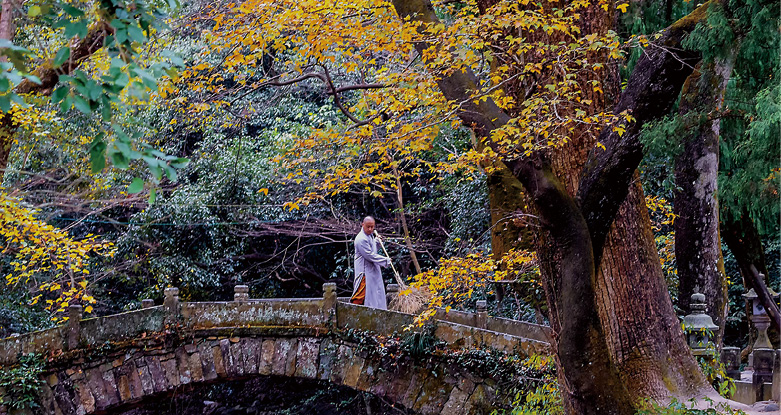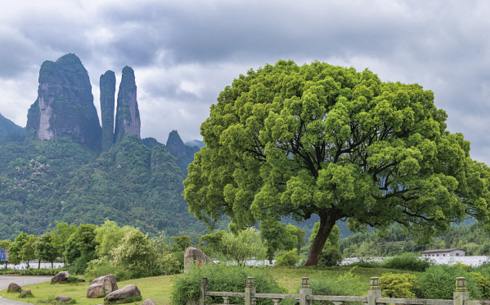





It was the Tang dynasty (618 – 907), a golden age of ancient Chinese literary culture, and the Tiantai Mountains (天台山) were all the rage among Daoists, Buddhists, and eccentrics.
Poets, monks, hermits, artists, and scholars flocked to the mountain range in eastern Zhejiang, where it was almost a rite of passage for literati to visit the misted peaks and caves. The poet Yuan Zhen (元稹) wrote of an encounter with another poet, “We met, and spoke again of going to Tiantai.” In total, poets of the era left 1,200 poems chronicling Tiantai's majestic and mysterious landscape.
Luckily for visitors today, Zhejiang province has begun the “Path of Poetry,” a project that retraces the region's ancient poetic culture. The proposition is almost like a scavenger hunt, knowing that cave-dwelling hermits like Hanshan (寒山)—who later became a patron saint to Jack Kerouac, Gary Snyder, and the American Beats—have scrawled hundreds of verses directly onto Tiantai's cliffs, in line with Daoist principles of namelessness and impermanence.
Modern historian An Zuchao calls Tiantai the “rich ore” of Tang poetry. As a former history teacher, he took his students to visit the sites of ancient poems, including Li Bai's Tianmu Mountains (天目山), which are a northern extension of the Tiantais. In “Ascending Mount Tianmu In A Dream,” the poet wrote, “My path twisted through a thousand crags...Below me, a bottomless void of blue...My heart was seized by fear and wonder.”
After 30 years of research, An sorted through all 50,000 surviving Tang poems to publish the anthologyTang Poetry of Tiantaiin 2018, concluding that a mind-boggling ratio of one in 44 poems from the Tang dynasty refers to the Tiantai Mountains. “I want to render the poetic culture of Tiantai visible, to make people yearn for it,” An told a county newspaper upon his book's publication.
The place to begin one's explorations of Tiantai is Guoqing Temple (国清寺), one of China's most important Buddhist establishments. It is a sprawling complex on the high slopes of a mountainous ravine, consisting of over 600 temples, halls, and gardens organized along five axes. The Guoqing Temple was founded in 598, and rebuilt in the Qing dynasty (1616 – 1911).
The temple is legendary in Buddhist history for birthing the eponymous Tiantai (Tendai) sect of Mahayana Buddhism. For centuries, devotees from across East Asia gathered at the temple to seek the dharma and brought the lessons back to their own countries, seeding new branches of Buddhism in Japan in the 7th century and Korea in the 11th century.
Among Guoqing's cultural treasures are stone carvings, scriptures, calligraphy and paintings, wood carvings, jade ornaments, Buddha statues, and ancient scrolls in Sanskrit. Strolling through the stone courtyards, practicing monks in yellow-gray robes shuffle past in what is still an active site of worship, nearly a millennium and a half after it was founded.
The Guoqing Temple's kitchen is said to be the former home of poet Hanshan's companion Shide (拾得).Together, Hanshan and Shide were said to have reveled in the ravines near the temple, flouting strict meditation schedules to find pure ecstasy in nature. Later painters would draw them with ragged clothes and disheveled hair, laughing wholeheartedly. Notable nearby sites include the Shiliang Waterfall (石梁飞瀑) and Hanshan Lake (寒山湖).
Visitors today can follow in the footsteps of hundreds of literary eccentrics and luminaries in the Tiantai Mountains. While none have found the exact location of Hanshan's cave dwelling on “Cold Mountain,” where he lived for over 30 years, the poet himself offered a crucial clue: “Men ask the way to Cold Mountain,” goes one of Hanshan's verses. “If your heart was like mine, you'd get it and be right here.”

Every summer, China's rich and famous flee to the Mogan Mountains’ (莫干山) lush, cool valleys, home to 127 square kilometers of bamboo forests—as well as over 200 villas belonging to Chinese and international celebrities. Both Mao Zedong and Chiang Kai-shek have stayed here.
One of Chinese Buddhism's Four Sacred Mountains, Mount Putuo (普陀山) of the Zhoushan Islands is home to over 30 major temples, including the historic Puji (普济寺), Fayu (法雨寺), and Huiji Temples (慧济寺). Millions of devotees gather at Mount Putuo every year to celebrate the birthday of the bodhisattva Guanyin.
The Ming dynasty (1368 – 1644) geographerXu Xiake (徐霞客)described the Jianglang Mountains’(江郎山)peculiar and majestic danxia (丹霞) rock formations as “odd,” “rugged,” and “mysterious” in his three trips to the area; some call them “skyscrapers planted in the clouds” today. In 2010, the Jianglang were inscribed as a World Heritage Site.
The Tianmu Mountains (天目山), whose name literally translates to “eye of heaven,” receive their title from two ponds on a pair of twin peaks, which reflect the sky in an eternal, unblinking gaze. Named a UNESCO Biosphere Reserve, Tianmu's habitat of wild ginkgo trees, along with 2,000 others species of flora, are home to over 50 endangered or protected species, including the clouded leopard and black muntjac deer.
Hikers may enjoy the trek up Huangmaojian (黄茅尖)of the Fengyang Mountains (凤阳山), the highest peak of the Yangtze River Delta at 1,929 meters. What the trail lacks in difficulty, it rewards in scenery—beginning in a forest of thousand-year-old trees, and ascending into windswept grasslands that bloom into swaths of azaleas in the spring. Viewed from the peak, the sunrise and sunset often drape the surrounding mountains in a sea of golden clouds.
